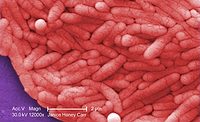TECH FLASH
Can your robot debone poultry?


|
| Gary McMurray, chief of GTRI's Food Processing Technology Division, poses with the Intelligent Cutting and Deboning System, which uses advanced imaging technology and a robotic cutting arm to automatically debone chicken and other poultry products. Source: Gary Meek. |
Deboning chicken breasts has always been a labor-intensive job, and not a very safe one at that. Attempts have been tried to design equipment that could successfully debone chicken, but have not enjoyed much commercial success. Researchers at Georgia Tech’s Research Institute (GTRI) have developed a prototype system that uses advanced imaging technology and a robotic cutting arm to successfully debone chicken and other poultry products.
The Intelligent Cutting and Deboning System uses a 3-D vision system that determines where to cut a particular bird. The device automatically performs precision cuts that optimize yield, while also greatly reducing the risk of bone fragments in the finished product.
“Each bird is unique in its size and shape,” says Gary McMurray, chief of GTRI’s Food Processing Technology Division. “So we have developed the sensing and actuation needed to allow an automated deboning system to adapt to that individual bird, as opposed to forcing the bird to conform to the machine.”
With the automated system, a bird is positioned in front of the vision system prior to making a cut. The vision system works by making 3-D measurements of various location points outside of the bird. Then, using these points as inputs, custom algorithms define a proper cut by estimating the positions of internal structures such as bones and ligaments.
“Our statistics research shows our external measurements correlate very well to the internal structure of the birds and, therefore, will transition to ideal cutting paths,” says Michael Matthews, GTRI research engineer. “In our prototype device, everything is registered to calibrated reference frames, allowing us to handle all cut geometries and to precisely align the bird and cutting robot. Being able to test all possible cut geometries should enable us to design a smaller and more simplified final system.”

|
| A robotic system used in the Intelligent Cutting and Deboning project prepares to slice through the shoulder joint of a chicken. The system, developed by the GTRI Food Processing Technology Division, is pursuing two goals: cutting close to the bone to maximize breast meat yield and ensuring food safety by avoiding creation of bone chips. Source: Gary Meek. |
The prototype uses a fixed two-degree-of-freedom cutting robot for making simple planar cuts. The bird is mounted on a six-degree-of-freedom robot arm that allows alignment of the bird and cutting robot to any desired position. The robot arm places the bird under the vision system, and then it moves the bird with respect to the cutting robot.
The system employs a force-feedback algorithm that can detect the transition from meat to bone. That detection capability allows the cutting knife to move along the surface of the bone while maintaining a constant force. Since ligaments are attached to the bone, maintaining contact with the bone allows the knife to cut all ligaments around the shoulder joint without cutting into the bone itself. A similar approach can be used for other parts of the bird where meat must be separated from the bone.
“There are some very major factors in play in this project,” says McMurray. “Our automated deboning technology can promote food safety since bone chips are a hazard in boneless breast fillets. But it can also increase yield, which is significant because every 1 percent loss of breast meat represents about $2.5 million to each of Georgia’s 20 poultry processing plants.”
Looking for a reprint of this article?
From high-res PDFs to custom plaques, order your copy today!





